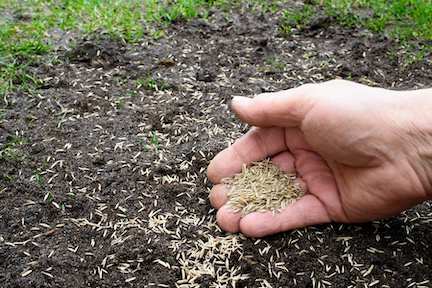Cultural practices are arguably the most critical component of PJC Organic’s Healthy Turf Circle. While we love talking about Soil Chemistry, Soil Biology, and Soil Structure – Cultural Practices are the unsung hero of our Organic Turf Care programs. There’s more to cultural practices than height of cut and aeration. Therefore, October is the perfect time to address 2 important fall cultural practices to finish the season strong and set yourself up for success next spring.

Practical Approach to Organic Turf Care
Take a closer look at these two important fall Cultural Practices to knock off your list…
1. Repair and Regrade
Whether your organic turf care program is supporting sports or backyard barbecues, a level surface is critical to safety, drainage, and coverage. Evaluate areas that need repair and regrading to address the issue while it’s small. First, identify holes and uneven areas that compromise safe use. Not only are these areas unsafe, but they also worsen with time and therefore impact the surrounding turf.
Second, examine high traffic areas that always need extra attention (i.e. goal mouths, face off “X”, or baseball outfield positions). Third, list your areas in order of priority for repair. Always address safety first, regardless of the size of the problem. Then, work within your budget to maximize repairs each year. Be sure to get on top of these areas while the repair is small—these damaged areas are like tooth decay and will not get better on their own.

PJC Organic recommends using a loam-based compost blend and over seeding with any of our suggested seed blends. If you are looking for quick coverage – especially in the fall, over seed with a perennial rye blend (can germinate in as little as 3 – 5 days) – just realize it may not do well in next summer’s heat and sun. For home lawns, a 50/50 (Kentucky blue/ Perennial Rye) or 70/20/10 (Turf TYpe Tall Fescue/Kentucky blue/Perennial Rye) will do just fine – just be aware that the Kentucky blue on average takes 21 days to germinate and turf type tall fescue takes 10 – 14 days.
A great tool for leveling areas is a leveling rake. A rake is an easy way to level the area to the adjacent areas for a consistent playing surface.
2. Adjust Your Water Cycles
PJC Organic recommends following the 1-2-3-2-1 watering method over the course of the growing season. In New England, we can rely on cooler temperature and rainfall on the front end and back end of the season. While summer weather has become more unpredictable, we can still rely on environmental conditions in the spring and fall. For this reason, you should only be watering once per week this time of year.
Turf grass generally requires 1” of water/week. Water depth can be challenging to understand in terms of time and sprinkler head style. Make sure the day of the week you select for watering is one that gets minimum traffic. If we are getting adequate rainfall, turn your irrigation system off – excess water can lead to compaction and disease, so be mindful of weather conditions.
Here’s a quick breakdown for the most common heads being used to get 1” of water/week: Pop-Up (30 Minutes), Rotary Heads (1:15-1:30 Hour), Pinwheel (1:20 Hour). *This is an approximation; be sure to check your own systems for time and coverage.
… for the Next Generation
The overall success of an Organic Turf Care program is based on consistency over time. Taking a holistic approach to your program is essential. Therefore, looking through the lens of the Healthy Turf Circle will provide you the tools to succeed. Cultural Practices, Soil Biology, Soil Chemistry, Soil Structure are the core tenets to PJC Organic’s turf care standards. The end of the season is close and adding these three important fall cultural practices is going to pay dividends. Check out our full list of Fall Organic Turf Care Tips for additional recommendations.
